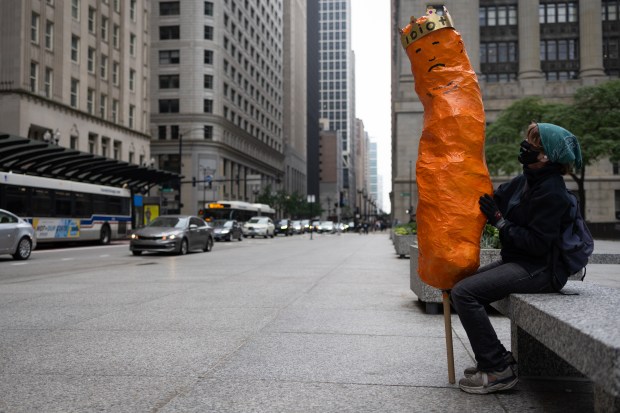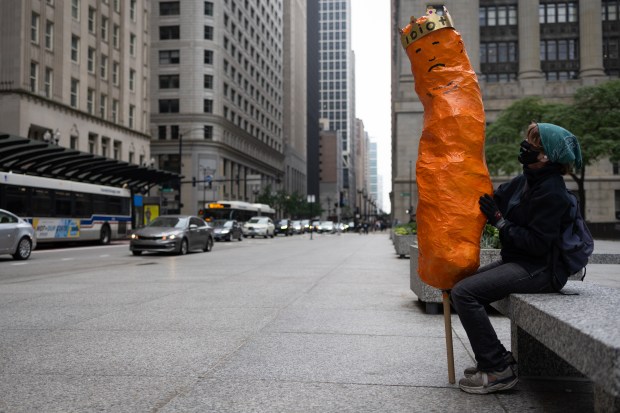“The dictator craze,” they called it.
In the worst of the Great Depression, a time of 25% unemployment, some called for an American-style dictatorship. Democracy wasn’t working very well, time for a change, argued the American Legion veteran’s organization: In a 1932 resolution, it declared the “present situation” too threatening for “existing political methods.”
Some in the media echoed the sentiment. Barron’s magazine acknowledged the paradox of a dictatorship course-correcting a broken capitalist democracy. But it was worth a shot, as long as our dictator was a “genial and lighthearted dictator … a mild species of dictatorship.”
Hollywood loved the idea, though it had little use for words like “lighthearted” or “mild” in what the screen trade publications nicknamed the dictator craze. It wasn’t all about politics: Some of the tyrants were murderous railroad tycoons (“The Power and the Glory,” 1933) or corrupt but frisky reform-school reformers (“The Mayor of Hell,” 1933).
Some made their money in retail and would do anything to keep it: The department store magnate played by Warren William in another 1933 drama, “Employees’ Entrance,” was a prime example. At one point, the man whose business motto is “smash or be smashed!” goads a hapless employee to suicide (“When a man outlives his usefulness, he ought to jump out a window!”) while converting former enemies into admirers.
“I thought there was such a thing as honesty and cooperation and sincerity in the business world,” says one of his business victims, now on the payroll. “I found out differently.”
In this sub-genre of early ’30s films, in the pre-Production Code enforcement era, bad behavior could get pretty rough and still deliver a charismatic, heartless despot as a hero for sale, designed for weary Depression-era movie audiences desperate for answers.
The movie to beat, though, is purely political and purely nuts, with a behind-the-scenes story of equal improbability. Its shadow collaborators included the one-man media conglomerate and Hollywood player William Randolph Hearst and an unofficial script supervisor, the recently elected President Franklin Delano Roosevelt.
The result? “Gabriel Over the White House,” a commercially successful provocation in 1933, released a few weeks after FDR’s inauguration, through Metro-Goldwyn-Mayer by way of Hearst’s own Cosmopolitan Productions.
For many chroniclers of American politics and American movies, “Gabriel Over the White House” stood apart, and does still, as the sole “dictator craze” film suggesting in earnest that democracy and the usual checks and balances worked fine, once upon a time. But in a crisis, no.
Director Gregory La Cava’s blend of piety and pulp “hasn’t had the kind of life in our popular imagination that more democratically-spirited films of the ‘30s have, like “Mr. Smith Goes to Washington,” says author and Brandeis University professor Thomas Doherty. His books include the seminal “Pre-Code Hollywood: Sex, Immorality and Insurrection in American Cinema, 1930-1934,” a detailed analysis of studio pictures unleashed, unchained prior to Hollywood’s more stringent Production Code enforcement begun in mid-1934.
Doherty devotes a chapter to “Dictators and Democrats” and a lot to “Gabriel Over the White House.” He considers “Mr. Smith” a kind of “anti-‘Gabriel’ film, about a man of the people (James Stewart) using democratic processes.”
In “Gabriel,” that stuff’s the bunk. The movie begins with the swearing-in of a new president, Judd Hammond, played by Walter Huston, well-known at the time for his portrayal of Abraham Lincoln on screen three years earlier. No game-changer or Depression-beater, Hammond is an easygoing hack with zero political principles. He dismisses America’s crippling unemployment and rampant gangland violence as “local problems,” the responsibility of the states, or cities. Not a national concern.
The bachelor president puts his mistress on the payroll as a secretary, and shows little interest in reports of a massive “Army of the Unemployed” marching toward Washington, D.C., in protest. That part of the “Gabriel” storyline comes from real life: the 1932 Bonus Army march on the capital, made up of World War I veterans and their families, on the ropes. Hammond was modeled in part on two 20th century U.S. presidents, Warren G. Harding and FDR’s passive predecessor, Herbert Hoover.
Soon enough, “Gabriel Over the White House” careens headlong into fantasy. A high-speed car accident, with a giddy Hammond behind the wheel, leaves the president in a coma. At death’s door, Hammond is visited by the archangel Gabriel, indicated visually by a breeze through the curtains and enough pearly white light to make the point.
He wakes up a new man. The do-nothing Hammond of old has vanished, replaced by a new, divinely inspired Hammond, full of certainty and resolve and great ideas for national renewal spanning a boggling ideological spectrum.
His first few executive orders lean leftward; refusing to send the U.S. Army to halt the unemployed veterans’ march by force, he opts instead to feed them. “What’s to prevent us from putting food into the mouths of the hungry?” he asks, not looking for a debate.
In a striking fictional blueprint for Roosevelt’s imminent New Deal initiatives, Hammond establishes an “Army of Construction” to put the hungry veterans and others back to work. What is this, some sort of Socialist love-in? Mere minutes of screen later later — even under director La Cava’s uncharacteristically staid direction, nothing takes long in pre-Code movies — Hammond swings the other way, acting like an authoritarian verging on a fascist.
Congress doesn’t like this new, unpredictable Hammond, and considers impeachment. Hammond calmly suspends Congress until further notice, declares martial law and the next newspaper headline we see reads “HAMMOND – DICTATOR.”
From there “Gabriel Over the White House” lets Hammond do what he likes because he has God on his side, plus (it’s implied) the spirit of Abraham Lincoln. He creates a private federal army to do his bidding. He sets up secret tribunals to execute gangsters by firing squad, with the State of Liberty in the background. Hammond becomes an unaccountable mashup of left, right, Socialist and fascist impulses – an anti-war leader who threatens other nations with total annihilation if they don’t sign his peace treaty.
Author, columnist and longtime political commentator Jeff Greenfield has lectured and written on “Gabriel Over the White House” and its persistent relevance to various and recent examples of American political chaos. The film, he says, also speaks directly to its own historical moment.
“The movie’s whole idea of mobilizing the unemployed,” Greenfield notes, “is speaking directly to Roosevelt’s first 100 days. The other stuff? Martial law, rounding up criminals, executing them without a trial? That’s a different kettle of fish.” The film is “all but forgotten,” he says, because “after World War II, the idea of a dictator, or a Caesar, got a lot less attractive.”
Recently reissued on Blu-ray, as part of the Warner Archives Collection, “Gabriel” made its own off-camera history in addition to what’s on the screen. An unusually rushed production schedule led to what we have now: two intriguingly different movies. The U.S. version is one thing; the European release version is somewhat altered in its political messaging.
Essentially the European cut was the one written and filmed for American consumption, then toned down by the Motion Picture Production Code. MGM’s Louis B. Mayer was a key player in that cleanup effort. He hated the film; a hard-line conservative, Mayer saw it as crude pro-FDR propaganda, a pet project of Hearst’s production company.
As recounted by Jonathan Alter, author of “The Defining Moment: FDR’s Hundred Days and the Triumph of Hope,” the timeline goes like this: Hearst fails to get his “America First” presidential candidate Jack Garner nominated in the 1932 Democratic National Convention in Chicago. He then throws his weight behind Roosevelt.
“Hearst believed that the country needed a dictator,” Alter writes, “but he wasn’t sure FDR knew how to fill the role. So in February 1933, he set out to show Roosevelt the way.” The way had a title: “Gabriel Over the White House.”
Hearst options the book, published in early 1933 in America by an anonymous writer. The subsequent British publication named the author as Thomas Frederick Tweed, advisor and chief of staff to the former British Prime Minister David Lloyd George, who was a friend of Hearst’s as well as a contributing opinion writer for the Hearst wire services.
Hearst and the film’s producer Walter Wanger got to work with their hired writers on a screenplay, hiring La Cava, later the director of “My Man Godfrey” (1936), “Stage Door” (1937) and other sterling achievements, to direct. Beyond the credited screenwriters, Hearst himself invented some of the longer, stodgier Hammond speeches regarding war debts and “our existing social system” which “has practically destroyed itself.”
The film, as “Hearst Over Hollywood” author Louis Pizzitola put it in his book, was conceived from the beginning as “one of several cinematic inauguration gifts” Hearst would bestow on the president-elect. Three weeks after his inauguration, Roosevelt requested a screening of the rough cut. He had notes. He preferred they remove a scene depicting an assassination attempt on Hammond’s life. (They did.) MGM’s Mayer, meanwhile, ordered several trims of his own, while Will Hays of the Production Code office took out the more direct suggestions of the affair between Hammond and his secretary.
The European cut retains that material, and lines such as “Well? Is it all right to kiss the President of the United States?” spoken by Karen Morley. Later, the European version contains a scene of Hammond’s chief secretary (Franchot Tone, later the leader of the federal goon squad eliminating the bootlegger problem) expressing deeply cynical views of his boss’s hack presidency, pre-spiritual conversation, not included in the U.S. version.
The larger differences between the two “Gabriel” versions arrive later, with Hammond’s peace summit at sea. In the European release, Hammond strikes a secret alliance with the British to make “a union of English speaking nations,” in one character’s words, and to prevent “the very destruction of Christian civilization.” This is not in the U.S. version; nor are Hammond’s fuller expressions of antiwar sentiment.
The movie had its champions in the press, a few, anyway, with The Hollywood Reporter predicting it would “probably go down in the history of motion pictures as the most sensational piece of film entertainment the world has ever known.” The Nation’s critic, reviling “Gabriel” for trying to “convert innocent American movie audiences to a policy of fascist dictatorship in this country,” nonetheless gave it props for exploiting “the current popular interest in social and economic ideas.”
Hollywood’s dictator craze may have been short-lived, “Pre-Code Hollywood” author Doherty says, but “Gabriel Over the White” captures the “absolute craziness of that particular political moment,” Doherty says. “It was a moment when America was willing to entertain a fascist who’s possessed by the spirits of Gabriel and Abraham Lincoln, who declares martial law, and who proves that the normal checks and balances of the U.S. government are just an impediment to get the country moving again.”
Michael Phillips is a Tribune critic.




